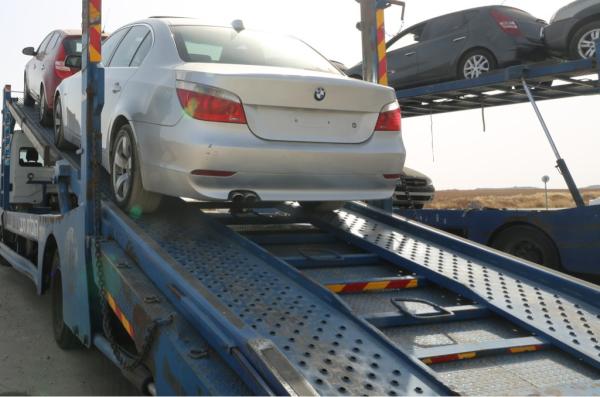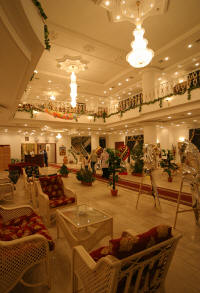On May 29, 2012, The New York Times published an article by Ruqaya Izzidien, “Shuffling Through an Underground Artery to Gaza.” While thousands of civilians are being slaughtered in Syria and terrorist bombs are exploding in Iraq, The Times publishes a puff piece that ignores the insidious truth about the smuggling tunnels between Egypt and the Gaza Strip. The story is yet another example of the editors’ penchant for humanizing Palestinian Arabs while demonizing Israelis.
Palestinian Arabs in the story are concerned that the reporter will bump her head inside the tunnel, they laugh and “guffaw” and wear “huge grins” on their “dusty, weathered” faces. Indeed, the reporter’s Arab subjects have faces. The Israelis appear only in the form of an F-16 jet. Israelis “frequently” target the tunnels “in airstrikes, which usually trap and kill workers.”
The article mischaracterizes the nature of the tunnels. Izzidien reports that Gazans consider “the tunnels a legitimate trade and passenger route, one that is necessary for survival in light of the blockade.” Izzidien ignores the fact that Israel facilitates the importation of thousands of tons of all manner of goods into the Gaza Strip every day.
Worse still, Izzidien contends that Israel targets the tunnels with airstrikes because “the Israeli government views the tunnels as an illegal smuggling route.” There is no mention anywhere in the article of weapons smuggled through the tunnels. There is no mention of Iranian terrorist trainers entering Gaza through the tunnels. There is no mention of materials brought in to construct rockets and missiles that rain destruction, injury and sometimes death on Israeli civilians.
Israel Facilitates the Importation of Goods into Gaza
According to The Times, “Gaza still depends on the tunnels for most of the basics, like food, building materials and clothes, as well as luxuries like electronics, cars and even wedding dresses.”
Naturally, a smuggling operation doesn’t publish the number of tons of goods it moves, but in order for the above statement to be true, the volume of goods smuggled through the tunnels would have to exceed that which Israel allows through legitimate crossings. How much is that?
Every day, the Israeli Defense Force announces the volume of supplies entering Gaza through Israel. On the IDF Spokesman Twitter feed, real time information is shared. For example, on May 30, the IDF tweeted that:
Yesterday, 6,091 tons of goods & gas (including 183 tons of soft drinks) entered #Gaza from #Israel.
This means that on the very day Izzidien’s article was published, over 6,000 tons of goods entered Gaza from Israel. This is not a rare occurrence. The day before, the IDF tweeted:
Yesterday, 5,851 tons of goods & gas (including 360 tons of fruits) entered #Gaza from #Israel.

Every week, the Coordinator of Government Activities in the Territories Unit (COGAT) publishes a detailed report of activities. For the week of May 20-26, 2012:
- 1,227 truckloads (32,741 tons) were imported to the Gaza Strip.
- 1.2 million liters of heavy-duty diesel for the power plant was delivered.
- 1,117 tons of cooking gas was transferred.
The Times claims that “most” of the food, building materials and clothes coming into Gaza travels through the tunnels. According to the COGAT report, Israel facilitated the transfer of:
- 324 truckloads of food
- 341 truckloads of construction materials
- 34 truckloads of clothing and footwear
It strains credulity to believe that more than that is smuggled through the tunnels every week. Especially when, as reported in 2010, the managers of a mall in Gaza “say 90 percent of its new stock is imported from Israel.”
Izzidien reports:
“This is our life,” said one of the workers, his face iced in a layer of white dust. “Life is expensive, and Rafah is even more high-priced than Cairo. So we are forced to work and live underground.”

The Real Purpose of the Tunnels: Supporting Terrorism
With so many materials being trucked into Gaza from Israel and with a theoretically open border between Gaza and Egypt, who would need to use the smuggling tunnels? By definition, smugglers — smugglers bringing in illegal goods, criminals and weapons.
The Shin Bet is Israel’s internal security agency, akin to the U.S. FBI. According to Shin Bet chief Yoram Cohen, Iranian agents have entered the Gaza Strip to train the roughly 20,000 Hamas and Islamic Jihad terrorists there. Cohen added that large numbers of shoulder-launched missiles and rockets from Libya are being smuggled into Gaza which he referred to as a “giant arms warehouse,” with Hamas possessing 8,000 rockets with a range of four to forty kilometers, that is, up to 25 miles, capable of hitting the Israeli cities of Ashdod and Beersheva, for example.
The Meir Amit Intelligence and Terrorism Information Center releases a weekly briefing. The edition which covers the week of May 23-29, 2012 reports that:
The Egyptian security forces exposed a large weapons store in one of the villages near Damietta, a city in the northeastern Nile Delta near the sea. The weapo ns came from Libya and were apparently meant for Hamas, to be smuggled into the Gaza Strip through the tunnels. There were about 100 rockets, hand grenades, mortar shells and automatic weapons (Al-Wafd portal, May 20, 2012).
Izzidien should have known about this weapons cache, likely meant to be smuggled through the same tunnels she was traversing. It was widely covered as early as May 20 by outlets ranging from the Russian outlet, RT, to Bloomberg. Bloomberg had the number of rockets as high as 191 and RT reported that the cache “included 120 surface-to-air missiles, 30 ground-to-ground missiles, 15 Grad rockets, 25 anti-tank grenade launchers, TNT and navigation systems.”
The ramifications of the weapons smuggling are obvious. Terrorist attacks against Israeli military and civilian targets continue. Amit states:
On May 23 Palestinian snipers shot at an IDF force engaged in routine counterterrorism activities near the security fence near Kissufim in the central Gaza Strip. The attack wounded one officer and one soldier, who were evacuated to a hospital for treatment. The force returned the terrorists’ fire (IDF Spokesman, May 23, 2012).
More recently, on June 1, 2012, again near Kissufim, IDF Medic Netanel Moshiashvili, 21, was killed in a clash with a terrorist who was able to reach the security fence, cut it and infiltrate Israel, according to available details. The terrorist was also killed. Several hours later, a mortar shell fired from northern Gaza exploded in southern Israel.
The IDF reports that in 2012 so far, there have been 270 rocket attacks on Israel from Gaza. Furthermore, according to the IDF:
More than half a million Israelis have less than 60 seconds to find shelter after a rocket is launched from Gaza into Israel. Most rockets launched from Gaza into Israel are capable of reaching Israel’s biggest southern cities.
Repeatedly throughout her article, Izzidien repeats her fear of “being bombed” by Israel as if the Jewish state targets the tunnels indiscriminately or, as she reports “often” and “frequently.” This is not true. The IDF acts in response to rockets fired at Israel and the policy is clear:
The IDF will not tolerate any attempt to harm Israeli residents, and will operate against anyone who uses terror against the State of Israel. The Hamas terror organization is solely responsible for any terrorist activity emanating from the Gaza Strip.
Protection from terrorist rocket and missile attacks emanating from neighboring territories is the least a citizen should expect from his or her government.
Similarly, honest, accurate reporting is the least a reader should expect from The New York Times. Unfortunately, The Times does not deliver. Instead, the paper offers a misleading and distorted report that fails to address lethal threats to Israel enabled by the tunnels. To the contrary, it falsely casts them as quaint, harmless and even necessary to the survival of Gaza residents.
In addition to the tendentious nature of this story, The New York Times also needs to be held accountable for the cumulative impact of the many human interest stories it runs that seek to portray, without even minimal context, Palestinian Arabs as victims and Israelis as victimizers. The Times claims to be “where the conversation begins.” Is it also where balanced and unbiased journalism ends?
